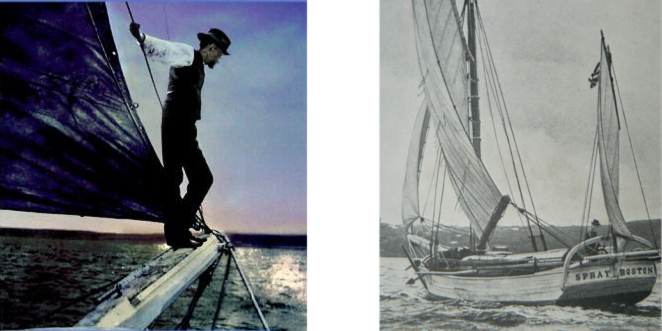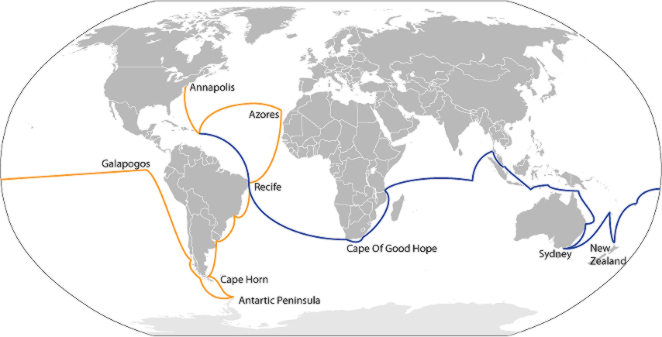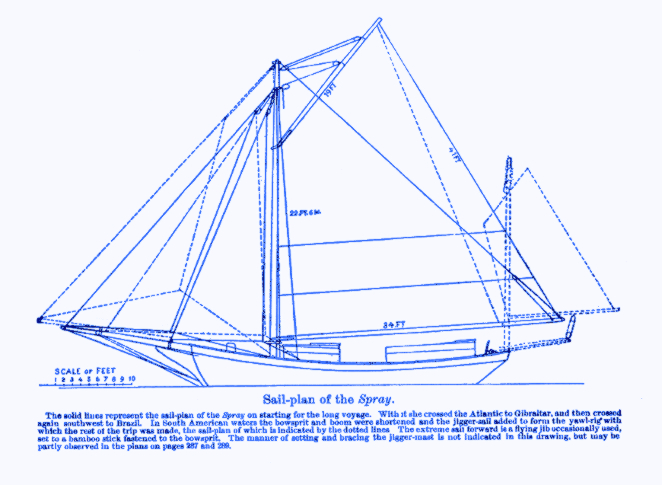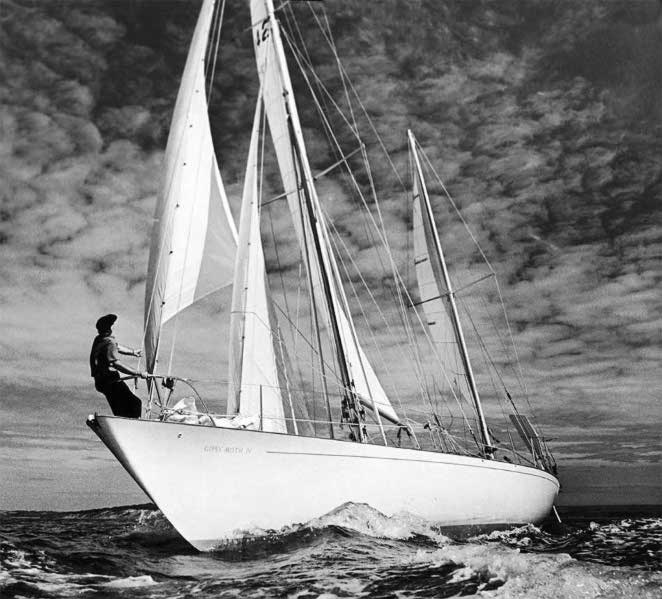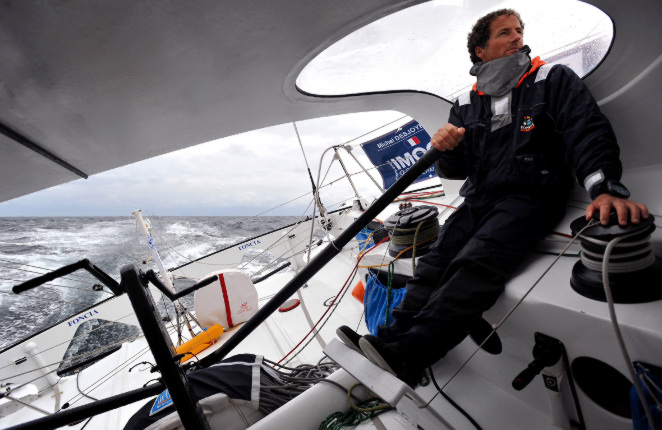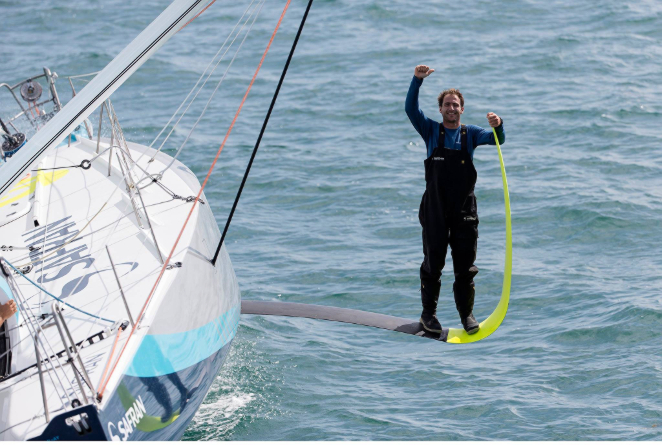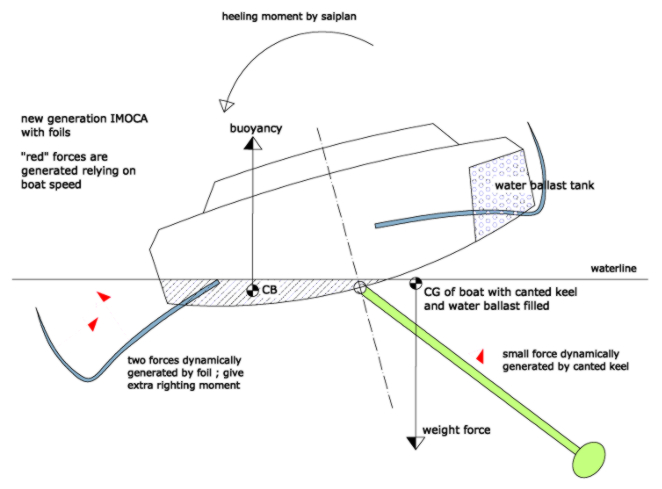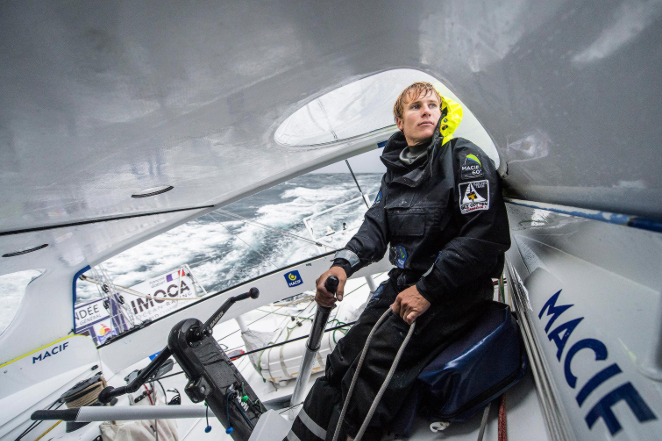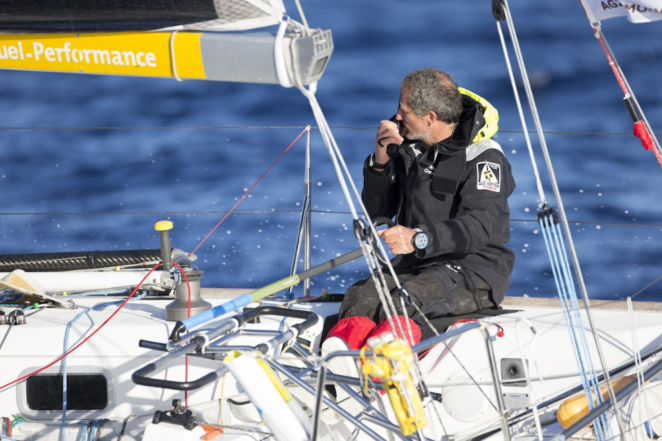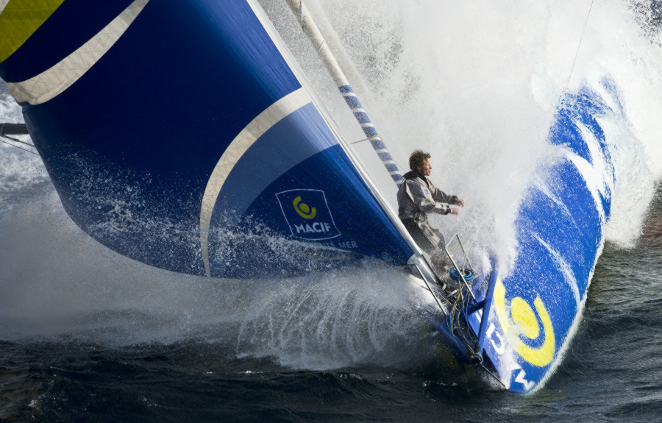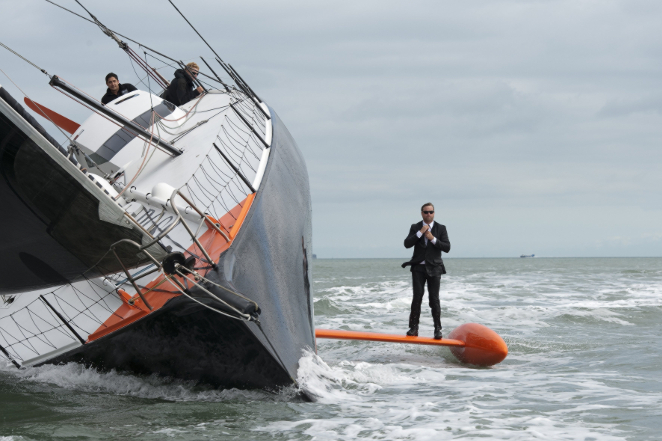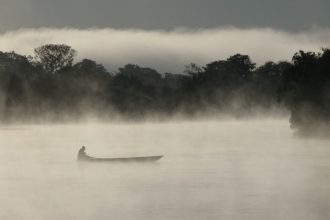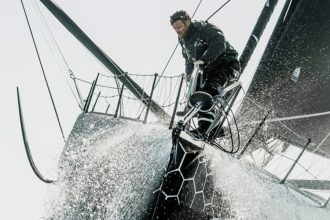Joshua Slocum’s Vandée
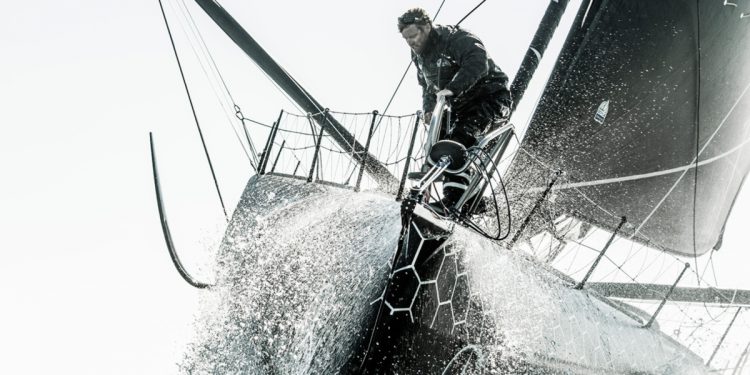
On April 24, 1895, at dusk, the Spray, a sloop a little over 11 feet long, later turned into a yawl, stepped out of Boston’s Port, headed eastward; on board was Captain Joshua Slocum, an experienced sailor who was then 51 years old and who had sailed in all the oceans of the world since the age of 16, on board, no one else.
Joshua Slocum and the Spray (Click the image to enlarge)
The Spray had almost a century, probably been built in 1801, and was given to Slocum in 1892, reduced to being scrap; Slocum, who had fallen into ruin following the sinking of the Aquidneck off coast of Brazil, his 326-ton brigantine was flawless, and being also an excellent ax master he completely reconstructed it in just over two years, “Balanced, robust and beautiful,” as well as of relatively little expense, as he will later write in his book, “Sailing alone around the world.”
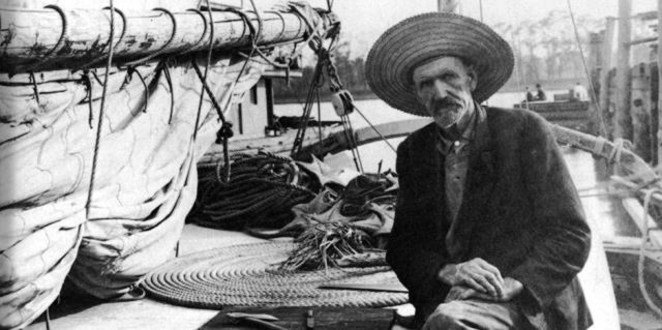
Joshua Slocum on the Spray
Björn Larsson, not I, says that it is a very good book, surely the best of its kind, confirmed by the success it has had since it was published, allowing its author to be resurrected economically and replicate in tone, in spite of being far less literary, the contemporary biography of Joseph Conrad.
After a brief spell in the Mediterranean, the Spray sailed through the Magellan Strait, overcoming months of atrocious difficulties, climbing the Chilean coast and crossing the Pacific to reach Australia, and then, beyond the Indian Ocean, it touched upon the coasts of South Africa, finally concluding the trip in the United States, casting anchor in the Newport’s harbor, after climbing the Atlantic from the opposite side than used at the beginning of the route.
Joshua Slocum and the Spray's voyage (Click the image to enlarge)
It was June 27, 1898, three years, two months and two days after departure, it was night-time, and the Spray, having sailed for more than 46,000 miles, had made the first round-the-world sailing alone, well before the invention of the windpilot, relying only on its incredible stability to stay on course, on the uncommon talent of its solitary crew, who had been personally at the helm for only a few days altogether, and on the priceless choice of meteorologically doable routes, those of Magellan.
Sail diagram of the Spray (Click the image to enlarge)
Of course, Slocum avoiding the South of the world had covered more than twice of the theoretically necessary route, and he had taken a lot of stops to rest, to supply himself, to sell his incredible adventures in crowded conferences, and because he had no speed record to beat , actually, he was setting another kind of record, one which had never even been imagined, and he was surely pleased to have established a giant leap forward for all of sailing, at the very moment in history when wind was being outperformed by the engine.
After him, and for many years, there would have been a vacuum, the world had many other problems, and only the Argentinean Vito Dumas had been successful in the challenge, becoming the first man between 1942 and 1943 to circumnavigate the South Pole alone on board the Lehg II.
Francis Chichester on the Gipsy Moth (Click the image to enlarge)
Then came other sailors, at the beginning were few, Bernard Moitessier and Francis Chichester were the most famous among those who have tasted the three oceans and the three great capes, then their number is gradually increased, and today the round-the-world solo has become a real specialization: boats are getting faster and faster, windpilots, automatic pilots, computer science have arrived, and in the last few years, materials, sails and equipment so futuristic and so technologically sophisticated so as to make the tour of the world in solitary an adventure similar to a Paris-Dakar race with a Formula 1 car, and without any pit stops.
Moitessier and Chichester, on board the Joshua and the Gipsy Moth, in the 60’s and 70’s, still navigated much as Slocum did, with boats that Slocum could have conceived and piloted, all shared by a common spirit of adventure and an identical culture of the sea, a culture that feared and respected the sea, who caressed it and didn’t challenge it.
Moitessier had gone to win the round-the-world tour, after doubling Cape Horn he was abundantly ahead in the race, but he thought about it and instead of turning north toward England he went on to Tahiti because he thought the seas of the south, where in fact he was born, to be much more beautiful and intriguing than the cold English seas: he would have spent all his life sailing, wrecking boats and retelling his adventures.
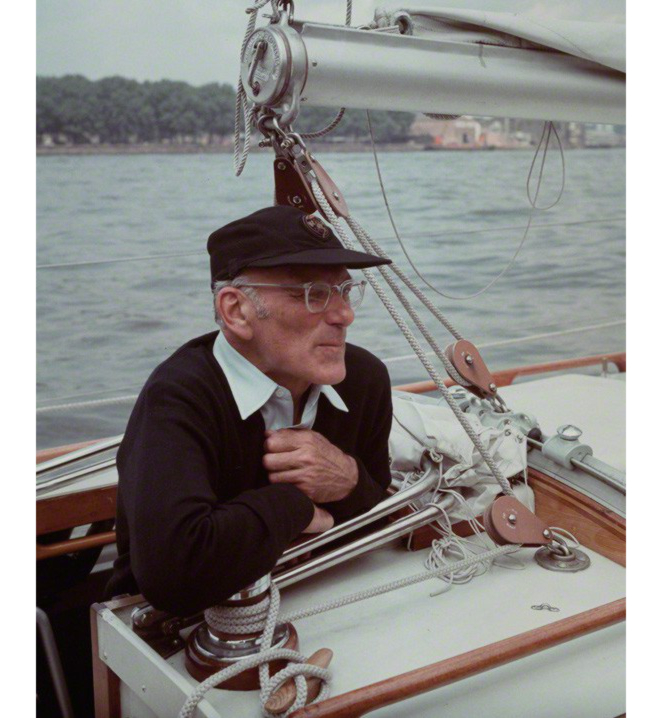
Sir Francis Chichester
Sir Francis Chichester had been an aviator and an aerial navigation expert whose work is still being used today, who at the age of 60 decided to take up sailing and go around the world on the Clipper Route; after a few years of oceanic apprenticeship, during which, among other things, invents and wins the Ostar, he left Plymouth in August 1966 and returned after 266 days, having made a single stop in Sidney earning title, glory and a place in the history of sailing.
Michel Desjoyeaux (Click the image to enlarge)
The sailors leaving today for the round-the-world are instead of a partially different breed, one which takes many confidences with the sea and sometimes pays the price; they are almost all French, only in France one finds a passion for the “le grand large” capable of bringing a million people to the start of the regatta, it is called the Vandée Globe, and capable of welocoming the last who reaches the finish line as if they were the first.
Since 1989, the Everest of sailing is climbed every four years starting from the base camp of Les Sables d’Olonnes, in the heart of the Vendée in the Pays-de-la-Loire region, which gives its name to the race, and after diving to the South Atlantic by touching the South American coasts, the boats roam towards the east by sailing around the Pole, leaving to their left the three great capes that border the world’s oceans, Good Hope, Leeuwin and Horn , then climbing the Atlantic till the port of departure, following a route that in the final stage crosses Slocum’s.
Morgan Lagraviere (Click the image to enlarge)
At that latitude, 40/50 degrees south, it is only 21,000 miles to go around the Earth, but half is traversed in the coldest and stormiest seas of the globe, far away from the most isolated islands and the most risky and desperate of commercial routes. Places where a timely rescue is completely impossible.
They are nearly 10,000 miles sailing downwind, and in those conditions the boats almost fly; Imoca 60, the current Class name, is 18 meters long, allowing them to easily achieve 24/25 knots and are so technologically sophisticated that after four years the winner of the previous edition can at best strive for average rankings, while after eight years they are considered old tools that newbies use to train on.
Drawing of how a leeward lifting foil works with the canting keel aboard (Click the image to enlarge)
They cost millions, and on board they have nothing that is economical, they all have the tilting keel that lifts up to 30 degrees to lower the boat’s shake, and those of the last generation have mounted lateral foils that lift the hull from the waterline and transform monohulls into multi-hulls; they have horrible names, obviously those of the sponsors, but it’s thanks to these boats that in 25 years the Vandée’s history has become a true maritime epic that brings together the ultimate in technology with the utmost adventure, and it weds the modernity of sailing with its ancient history and with some of the most ancestral pulses driving men.
Up to now, not counting the current one, there have been seven Vandée, a total of 138 boats have started the race, and 71 have arrived at the finish ; of the 67 different boats that were withdrawn several have been lost due to capsizing, hull rupture, keel disengagement, rudder or mast rupture or collision with floating objects, because today the Antarctic seas have become the dustbin of the oceans, and you strike something at 25 knots it is certain that will damage your boat seriously, when you’re lucky; finally, among all sailors, three have alas disappeared into the sea.
The numbers also tell us that from the 13 contestants of the first edition we have reached an average of about 25 competitors in the most recent ones, while to win the regatta the time has passed from the 110 days of the early 90’s to 78 days in 2013, with the winner that precedes the last plce finisher by at least a month, and often a lot more.
Francois Gabart (Click the image to enlarge)
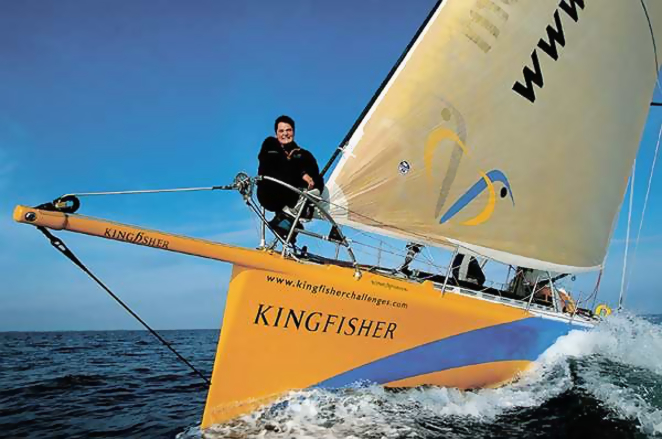
Ellen MacArthur
The race has its big winners and its big losers: among the first are Michel Desjoyeaux, twice the first at the finish, and François Gabart, winner against the odds as a rookie, not even 30 years old in 2013; among the second category one special mention goes to Ellen MacArthur, a feisty brit less than 1 meter sixty tall who, when she was 24 years old, gave Desjoyeaux a run for his money all the way to the finish line, after being slowed down to assist another competitor thatwasin trouble, recovered first place only to then be definitively put out of the race by a collision with the usual floating container in the North Atlantic, and relegated for this to a second place that was almost worth more than a win.
Michel Desjoyeaux (Click the image to enlarge)
The other two great losers still in action, the Frenchman Armel Le Cleac’h (who finally won in 2016), who’s come in second twice, and the Englishman Alex Thomson, who has for the first time a boat equal to the best, and maybe even the best of the lot, both are top conrenders. They are playing to win in the current edition, and part from the always possible breaks, one of the two, at the moment the French is in the net advantage, will fill in the zero from his win board, with a time that could be around 70 days. And although both of them have surely dreamt of the great seas in Moitessier’s books, neither of them will make a detour for Tahiti.
(n.d.r. Le Cleac’h eventually won La Vendée in 2016-17 in 74 days.)
Francois Gabart (Click the image to enlarge)
A century after Slocum, the world of solitary sailing is no longer just an adventure, you can’t set sail without having prepared the boat and practiced racing for four years, and without having spent a lot of money, sums that render ridiculous the 500 dollars that Slocum needed for the Spray‘s restoration. But after the start everything returns as before, as far as everything can be useful, in the end the staff on the ground counts for little, same for the technology, and it doesn’t matter that everything has been prepared to perfection, when boats are equal what counts are talent, wind sense, instinct for the wave, ability to avoid ruptures or to remedy them, precision in interpreting the weather and, as always, at sea luck counts for a lot. Especially when you go looking for the extreme limits of the boat, the wind and the waves.
Why do these men do it? Anyone who has gone by sea, who has looked up at a ten meter-high wave, there are a lot of higher ones out there , anyone who has surfed pushed by 30 or 40 knots of wind will answer that it is a stupid question, you engage in it because of the adrenaline, for the indescribable excitement that one feels, for the pleasure of competition, with others and with oneself, and dancing on the border that separates the challenge from a provocation to nature, a border that can sometimes be overcome ; it is also done in the end for money, but that’s just the last of the reasons.
There is one thing that separates solitary navigators from other men who are in danger when engaging in some athletic activity, apart from mountaineers, who, however, have to use essentially their own body’s abilities, not technological tools, and that is the empty theater in which the show is performed, diluted in very slow time: no one admires you, no one applauds you, all you do must be imagined, as the man alone in the middle of the sea must imagine the power of the wave that drives him in the night of the Antarctic seas .
There is the inner silence on which the noise of the waves crashes, there is the solitude on which the wind’s fury falls, but the waves and the wind are always the same, and the sea offers everywhere the same spectacle, a feeling that lasts long days or months, years in Slocum’s case, a feeling that belongs only those who test it, not those who look at it, and I think it’s a miracle that millions of people in the world try to imagine something they do not know and will never try .
Alex Thomson (Click the image to enlarge)
It’s an idea that begs the burden of proof, but if I look at Alex Thomson doing an acrobatic display for his sponsor by climbing in jacket and tie up to the mast head on the tilted boat, then diving into the sea, and I think of Joshua Slocum who first sold his solitary world tour to find himself and redeem his expense accounts, touching at the same time the extreme limit of his time and his own soul, I think that if he were alive today he be there, at the departure of the Vandée.
![]()

We thank all the many readers of Modus, that with their regular or sporadic visits give meaning to our work.
For those who would like to be informed in real-time about our publications, and have an active profile on Facebook, we recommend to add your “like” to the fan page : you will receive links to all our new articles.
Th

